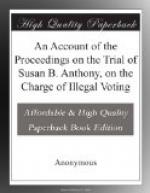With what jealous care the right of trial by jury in criminal cases has been guarded by every English speaking people from the days of King John, indeed from the days of King Alfred, is known to every lawyer and to every intelligent layman, and it does not seem to me that such a limitation of that right as is presented by the proceedings in this case, can be reconciled either with constitutional provisions, with the practice of courts, with public sentiment on the subject, or with safety in the administration of justice. How the question would be regarded by the highest Court of this State may fairly be gathered from its decision in the case of Cancemi, 18 N.Y., 128, where, on a trial for murder, one juror, some time after the trial commenced, being necessarily withdrawn, a stipulation was entered into, signed by the District-Attorney, and by the defendant and his counsel, to the effect that the trial should proceed before the remaining eleven jurors, and that their verdict should have the same effect as the verdict of a full panel would have. A verdict of guilty having been rendered by the eleven jurors, was set aside and a new trial ordered by the Court of Appeals, on the ground that the defendant could not, even by his own consent, be lawfully tried, by a less number of jurors than twelve. It would seem to follow that he could not waive the entire panel, and effectually consent to be tried by the Court alone, and still less could the Court, against his protest, assume the duties of the jury, and effectually pronounce the verdict of guilty or not guilty in their stead.
It will doubtless be insisted that there was no disputed question of fact upon which the jury were required to pass. In regard to that, I insist that however clear and conclusive the proof of the facts might appear to be, the response to the question, guilty or not guilty, must under the Constitution come from the jury and could not be supplied by the judgment of the Court, unless, indeed, the jury should see fit to render a special verdict, which they always may, but can never be required, to do.
It was the province of the Court to instruct the jury as to the law, and to point out to them how clearly the law, on its view of the established facts, made out the offence; but it has no authority to instruct them positively on any question of fact, or to order them to find any particular verdict. That must be their spontaneous work.




